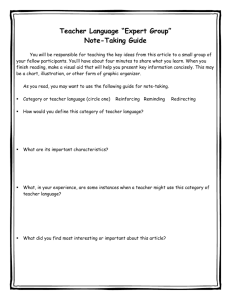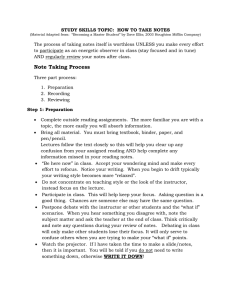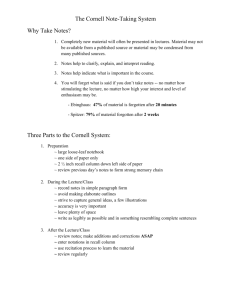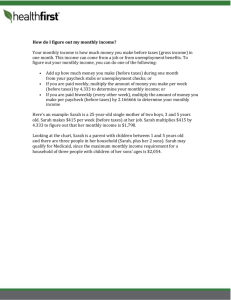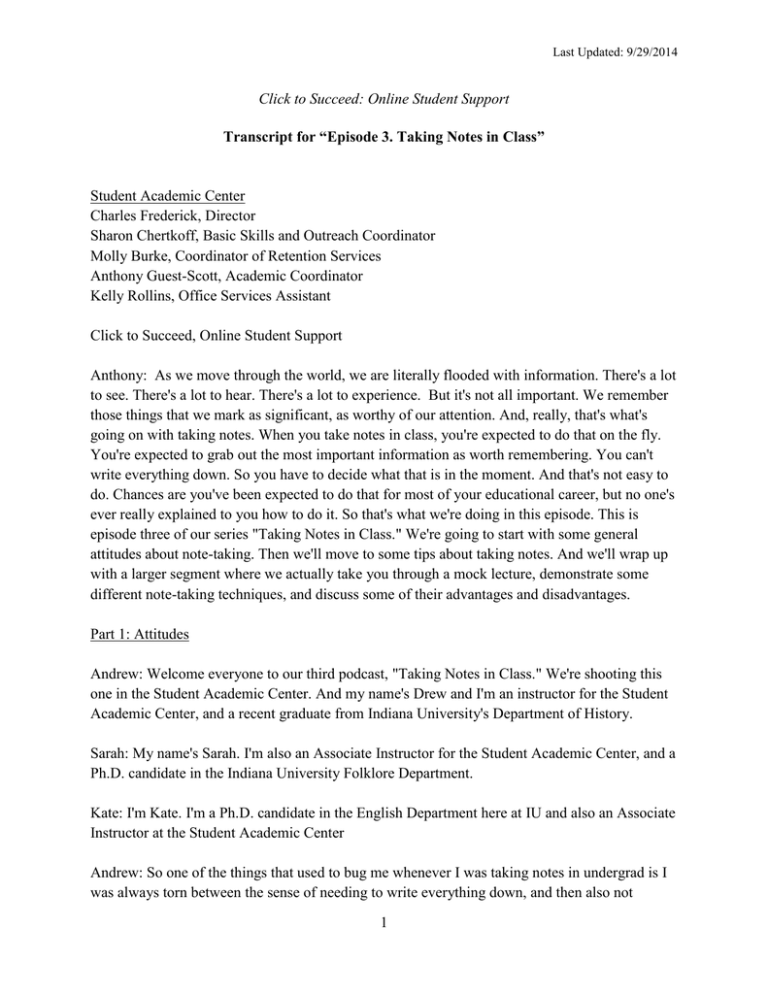
Last Updated: 9/29/2014
Click to Succeed: Online Student Support
Transcript for “Episode 3. Taking Notes in Class”
Student Academic Center
Charles Frederick, Director
Sharon Chertkoff, Basic Skills and Outreach Coordinator
Molly Burke, Coordinator of Retention Services
Anthony Guest-Scott, Academic Coordinator
Kelly Rollins, Office Services Assistant
Click to Succeed, Online Student Support
Anthony: As we move through the world, we are literally flooded with information. There's a lot
to see. There's a lot to hear. There's a lot to experience. But it's not all important. We remember
those things that we mark as significant, as worthy of our attention. And, really, that's what's
going on with taking notes. When you take notes in class, you're expected to do that on the fly.
You're expected to grab out the most important information as worth remembering. You can't
write everything down. So you have to decide what that is in the moment. And that's not easy to
do. Chances are you've been expected to do that for most of your educational career, but no one's
ever really explained to you how to do it. So that's what we're doing in this episode. This is
episode three of our series "Taking Notes in Class." We're going to start with some general
attitudes about note-taking. Then we'll move to some tips about taking notes. And we'll wrap up
with a larger segment where we actually take you through a mock lecture, demonstrate some
different note-taking techniques, and discuss some of their advantages and disadvantages.
Part 1: Attitudes
Andrew: Welcome everyone to our third podcast, "Taking Notes in Class." We're shooting this
one in the Student Academic Center. And my name's Drew and I'm an instructor for the Student
Academic Center, and a recent graduate from Indiana University's Department of History.
Sarah: My name's Sarah. I'm also an Associate Instructor for the Student Academic Center, and a
Ph.D. candidate in the Indiana University Folklore Department.
Kate: I'm Kate. I'm a Ph.D. candidate in the English Department here at IU and also an Associate
Instructor at the Student Academic Center
Andrew: So one of the things that used to bug me whenever I was taking notes in undergrad is I
was always torn between the sense of needing to write everything down, and then also not
1
Last Updated: 9/29/2014
wanting to do a whole lot of writing down because I wasn't sure if it was important. How did you
two experience note-taking when you were an undergrad?
Sarah: I definitely had those exact same problems. Often, if I look at my old notes from
undergrad, they have a distinct pattern. The first page, two pages, maybe three pages, are just
packed with words. And they have some kind of structure, but they're just packed with words
and that's when I was trying to write everything down. And then once I get through that first
page, two pages, they sort of start to dwindle off and it gets to the point where I'm not really
writing anything because I'm so exhausted after having tried to write all that stuff down at the
beginning; it all just sort [of] shuts down!
Kate: Yeah, I was a transcriber, too, but I would transcribe the entire lecture. I wanted everything
exactly how it happened word-for-word, and then I would never use my notes.
Andrew: So I wanted to begin with what seems, at first, like a simple question but actually one
that has a lot of answers. Why do we take notes?
Kate: Well, first of all to clarify what's actually important.
Sarah: To remember things. I mean, there are a lot of studies that show that the act of writing
things down really does help you to remember them. And it's actually important to realize that
there's a difference between writing it out long hand and typing it out on a laptop. There are a lot
of reasons to think that writing it out long hand really helps things to stick a lot better. And if you
take notes really well, it becomes the first stage of your studying process.
Kate: Absolutely. When you're taking notes, you're actually thinking, sorting, classifying,
organizing information. As Thomas Mann said "Order and simplification are the first steps
toward [the] mastery of a subject."
Andrew: All right, so if note-taking is something that requires a lot of concentration, what are
some tips for focusing so that I can have that kind of concentration in class?
Kate: All right, the first thing is to shut down the entire form of distraction that we always have
to deal with now, which is the phone has to go off. No Twitter, no texting. The computer needs
to not be something that you're using for Facebook, for email, for surfing the web, or for, you
know, mistakenly thinking you're using your time well by doing work for another class.
Andrew: So one of the things I hear you saying, Kate, is that concentration is actually something
that takes a lot of work. It doesn't just happen accidentally. You have to be purposeful about it.
Last question, then, when should I bother taking notes in class?
2
Last Updated: 9/29/2014
Sarah: All the time. It should absolutely be your default mode. Don't wait for the instructor to tell
you to start taking notes, just do it as soon as you sit down and keep doing it until you walk out
of class.
Andrew: This is where we start; we start with note-taking. Okay, so to recap, we take notes in
order to remember, certainly, but also to pay attention and also to help us to think and to clarify
the things that we're learning. We need to cut off our distractions, and we need to be focused,
which takes some kind of effort on our part. Now then, let's actually look at some specific steps
and tips for note-taking.
Part 2: Tips for Taking Notes in Lectures
Andrew: Okay, so now for some tips for the note-taking in class. There are three things that we
want to emphasize. The first one is active listening. The second one is dealing with speed, since
your instructor can talk faster than you can write. And then the third one is trying to get the
structure of the lecture.
Sarah: So first we gotta deal with active listening. The important thing to remember here is that
listening is more than just hearing. You don't want to be just sitting there in the lecture hall
letting the sound kind of wash over your ears as though it's going to trickle its way magically
into your brain. You have to be switched on, you have to be focused, paying attention, ready to
grab onto whatever information is important or interesting. It's a really important skill, and it's a
skill that you have to cultivate.
Kate: Okay, well how do you find out what's important? How do you know what are the key
ideas, and what do you actually write down?
Sarah: Active listening is going to help you do that, right? So to start, you can use it to listen
carefully to a lecture's speaking style. So not just to the words that they're using but how they're
saying them. Listen for rhythm. Lecturers often pause to let the impact of an important idea
really sink in. Sometimes they might repeat themselves, or they might slow down what they're
saying to really draw it out, to emphasize its importance. Listening to volume level is also really
important. Some instructors will get louder when they want something to be emphasized or
clearer. Or sometimes some instructors will get quieter to sort of emphasize that something is
serious or important. It's also really important to tune in to listen for signal words and phrases.
So, Drew –
Drew: Yeah.
3
Last Updated: 9/29/2014
Sarah: Will you give me a hand with this?
Andrew: Absolutely.
Sarah: Okay, so Drew is going to give us some examples of some signal words and phrases that
we can listen for. So, listen for phrases that frame what you're talking about.
Andrew: "We are studying this because…"
Sarah: Listen for keywords that are really self-evident.
Andrew: "This is really important!"
Sarah: How about items in a series, Drew?
Andrew: "There are three types of…"
Sarah: Answers to "why" and "how" questions?
Andrew: "Because…" or "On the one hand…"
Sarah: Can we get important examples?
Andrew: "For example, take this case!"
Kate: All right guys, I think we've got the picture about signal words but how do we deal with
speed? A lot of lectures go really, really fast.
Sarah: When you're writing, it's really important to use phrases and abbreviations. Don't try to
write complete sentences. By active listening, you can decide what's important and what you
need to write down. That comes back into play here and it's going to keep coming back into play
as we continue to talk about note-taking. It's also really important not to just copy down
everything you see on a PowerPoint. It's not a productive way of taking notes. It's not going to
help you to remember what you're doing as you're writing it down because all you're doing is
letting the words come in through your eyes and go back out through your hands on a page. I
mean as Albert Einstein said, "Any fool can know. The point is to understand."
Kate: Okay, so that's important, obviously, and the thing to remember is that we are going to
miss some words or some phrases some time. And that's true for non-native speakers of English
4
Last Updated: 9/29/2014
especially, but it's also true for native speakers of English. So that's a time to just leave it blank
and keep going. Don't get lost. Don't quit. Right? And then that's an opportunity afterwards to go
ask the professor and to say "Oh, I missed this part of the notes" or to ask a peer. And then
you've also made that extra effort to maybe start to create a formal relationship with the professor
or with somebody else in class who might end up being a good study buddy.
Sarah: Right, it can benefit you in so many different ways.
Sarah: So the third thing that we really have to make sure that you get while you're taking these
notes is to get the lecture structure. Some lectures are really just going to go all over the place.
Some instructors like to go on rants or tangents to tell stories, or just to jump from topic to topic.
In a moment, we'll talk about some different note-taking strategies that can be helpful to think
about if you've got to deal with instructors who are like that. But for the most part, lectures have
a pretty clear logic as to how they're organized. And it usually goes something like this: First,
most lectures start with announcements or some kind of recap of what you covered in the last
class. Next, there's going to be some kind of a thesis just like you have at the beginning of your
essay that tells you what the topic of the day's class is going to be. Then next comes the analysis,
so where there's support and explanation that's given to defend the thesis that comes at the
beginning. And then finally, you have a synthesis. So what are the big ideas? What is the take
away message that you're supposed to go home with and then bring back with you next day for
the lecture that follows up. So listen for those, and that's going to help you figure out how to
stretch your notes as you're going along.
Andrew: Okay, so the three things were active listening, getting a hold on the speed of the
lecture, and then number three, understanding the structure of the lecture. Now then, let's practice
all three of these.
Part 3: Mock Lecture & Note-Taking Techniques
Andrew: Okay, so for this exercise, I'm going to ask you at home to start taking notes for what
will be a mini lecture. This lecture won't be particularly long, only two or three minutes, but the
notes that you take we're going to compare to those that Sarah and Kate take. That way you can
have an idea what is your note-taking method like, and what are some other options that you
could employ. Now during the mini lecture, I'd ask that you pay attention to the words that I use
that might point out important things, or the cadence; perhaps the gestures that I use as well.
And, also, try to get the structure of this mini lecture. The lecture itself is taken from an
American history course that I teach, and the topic is the beginning and end of American history.
The difficult question isn't when to end American history. The difficult question is when to begin
American history. It's much easier to imagine that the class has a very clear starting point, but if
5
Last Updated: 9/29/2014
we begin to think about it very hard, we begin to realize American history, the beginning of it, is
actually something that requires some thought and some argument. So there are several possible
dates that we could use for our American history beginning. I'll suggest some possible dates and
also why they're good. So probably the first thing that comes to mind is 1776. This is often
considered the "birthday" of America - July 4, 1776. This is when our founding fathers famously
declared their independence from Great Britain. We were no longer British colonies. We had
now become an American collection of states. So 1776 certainly marks the national beginning of
American history. American, as in the United States of America. America proper. Another
option, though, is when the English colonists first arrived in America. And for that we could say
1607 Jamestown. [The] first English colonists arrived to the shores of Virginia; they set up the
first permanent English settlement in North America. That seems like a good time to start
American history as well, since so much of our heritage comes from England. That's not our only
option though. We know that in 1492 Columbus sailed the seas of blue. And this is a useful date
as well, because in 1492 almost everything changes on the North American continent and also in
Europe. You have rampant disease that hurts both populations. You have incredible use of raw
materials from the Americas and you also get dozens of years of war on the part of the European
powers after they discovered the new world. So this is also a pretty good year to start American
history even though it typically is used to talk about Caribbean or South American history. We
have a fourth option, and this one is an inaccurate date, because we simply don't know. But we
do know that as early as 1,200 B.C.; I'm sorry - 12,000 B.C., that there is a culture of Native
Americans at Clovis, New Mexico. And this date, plus or minus 1,000 or perhaps even older, is
one of the earliest archeological sites in North America, and we know that people have been here
that long.
Drew: Okay, so now we're going to talk about each of the note taking styles specifically. So let's
start, actually, with Kate. Kate, you started out with the Cornell Method. What were your
feelings about the effectiveness of that style?
Kate: There are a lot of reasons I really like the Cornell Method and you can kind of, vaguely,
see some of them on the page, right? First of all, the Cornell Method puts all of the actual
information in the center of the page, but on the margin you write your topics, right? And at the
very bottom, at the end of the lecture, you write a really brief 1 or 2 sentence summary about
what the main points are. I like it because it really gets you thinking analytically while you are in
lecture - so this what we talked about, right, sorting and organizing information - so this really
gives you key organization here based on your topics. It makes you think about what's important,
why it's important, the structure of the lecture, right? So I wrote down: "When does American
history start," "possible dates to start," "complication(s) of dates." and that comes straight from
the language you used Drew, but then that really keeps me in line thinking about these three
sections.
6
Last Updated: 9/29/2014
Andrew: Okay, so Sarah, your first technique was just a simple outline.
Sarah: I did outline notes, yeah. Here are my outline notes. So an outline is just a
straightforward, visual organization of your ideas. So, typically, you start with a Roman numeral
"I" with a major subject heading. You traditionally sub-head sections beneath that with capital
letters and then beneath that with regular numbers and you can kind of go in from there. I think
it's a very good way of organizing notes. I think it's very clear; it's visually very structured.
These Roman numerals, these capital letters really draw your eye to where these main ideas are;
it's very easy to see the kind of stair-step structure of which small ideas are contained within big
ideas. The downside of it is that it's very slow. I mean, you do a lot of writing to be doing this
outline style. I remember at the end of this, really just, I mean, a page, almost a page and a half
of notes in - what was it, a 5-minute lecture Drew? - and I was just.. I was shaking my hand by
the end of it just from trying to keep up so that is a little bit tough.
Andrew: So, let's move on. Kate, your second type of notes is what?
Kate: Bullets and sentences. So this is something I see a lot from my students. We love bullets,
right, because they seem to give us a sense of organization, but those undifferentiated bullets that
just run down the side of the page or full sentence note-taking… I know some [do it] in
paragraphs, which I didn't quite do, but I know some people really like to do that. The benefits:
you can go really fast, you're not making all the organizational decisions that you had to talk
about making, right? You don't make any of those, because there is no differentiation, there is no
hierarchy; everything gets the same treatment: new idea, new line; new idea, new line, right? So
it goes really, really fast and if you're stuck in a situation where the lecture's going fast, I can
really see the benefit of this. But the issue is you have to go back and organize it, because it just
visually looks like a mess, and I could imagine if I took notes like this for four weeks in a class,
even, it's just going to look like a jumble, right? It's going to look a mess and I'm not going to
know where to go look to find out how long ago the Clovis settlement was, or the particular
benefits and drawbacks of the 1607 date for the start of American history. That if you don't go
back later and impose some kind of structure on this it's really almost lost effort. So you have to
be willing to do that.
Andrew: Okay so let's switch to a fourth style. Sarah, you had a remarkable actual note-taking
this time.
Sarah: The basic idea is that this is supposed to be a visual or a graphical representation of the
connection between the different ideas that came from your lecture. This note-taking style can be
useful if you are dealing with a lecture that's particularly scattered - it feels like it kind of goes all
over the place - because you can just sort of try to follow that structure as best you can and
connect things linearly or try to create some kind of structure when there isn't anything. I think,
7
Last Updated: 9/29/2014
really, the biggest problem, also, with mind mapping as a note-taking strategy is that writing
down "complications with these dates" and then "1607" and circling both of them and putting a
line between them doesn't explain or clarify what the connection between those two concepts is,
it just says that there is one.
Andrew: Fantastic. That's a good appraisal. Okay, so now then, for the third round, you each did
just, like, your personal style which I imagine has pieces from different styles that you've kind of
meshed together for yourself. Kate, what was your personal style?
Kate: Okay, so, you're going to see a lot of the things in my personal style that you saw me
harping on. I like visual organization. I am a messy writer, but I like spatial organization on the
page. I don't like trying to pick out which Roman numeral I'm going to next, but I do like the
hierarchy to move in the page so the most important things on the right and then the related
information is below it and then often more, and then often more. So there is often a stair-step of
information in. I underline big topics. I put stars next to really important things; maybe a thesis,
maybe a question. I bracket things, often causational material, and I use round brackets if it's the
instructor's information and square brackets if it's mine.
Andrew: That's funny, I do the exact same thing!
Kate: You do the same thing?
Drew: Yeah.
Sarah: Well, and, the funny thing is that, if I just hold my notes up, they actually look on the
page quite similar in terms of the way they're laid out, right? Like, let's hold these up for the
camera next to each other. See? They look very similar in terms of the way they're laid out,
which is interesting. There are a few key differences, I think. I mean, I do tend to put Roman
numerals. The funny thing is that I actually don't have a pattern; like, I happened to put Roman
numerals here, which might have been influenced by the fact that two pass-throughs ago I had
done the outline style, but I do generally have some kind of large marker on the margin that
indicates new ideas. So it might be a Roman numeral, it might be [a] capital letter. I kind of like
that we're comparing our note-taking styles because, while they're so similar, where we've got
these sort of main introductory ideas at the top and then these bulleted dates with supporting
arguments and information next to them, it sounds like your personal code is far more elaborate
than mine.
Andrew: Okay, so we have gone over several different note-taking styles. There are a few others
including matrixes, and timelines, and charts. We'll have examples of all these on our blog. I
think the important thing to take away from our study today is that, regardless of what style of
8
Last Updated: 9/29/2014
note-taking you choose, you need to get some kind of ownership and familiarity with that style.
Now, Kate and Sarah are expert note-takers; they're graduate students, they've been doing this
for quite some time, and you need to invest that kind of time as well. Try out different styles in
classes, see which ones you like and don't be afraid to modify them so that they suit your needs.
Develop your own kind of code, and always be ready to tweak it if it's necessary. Eventually,
you'll be taking great notes, too.
The Take-Aways
Anthony: Okay, so here are the take-aways for Episode 3: "Taking Notes in Class." To take
better notes, I think we need to start by thinking a little differently about what notes can do for
us. We take notes for a whole of bunch of different reasons. We take them to clarify. We take
them to help us remember what we actually talked about in class. We take them to help us think,
to help us organize the information as we're receiving it. And we actually take notes to pay
attention so we can focus in on and lock in to what's right in front of us. When you start to think
about taking notes this way, then asking your professor for the PowerPoint lecture at the end of
class misses the point. Because it's the process of actually taking the notes that might be just as
important as the notes themselves. So the next time you get to class, turn off the cell, and always
take notes as the default unless you are specifically asked not to.
Once you're in class, here's the main challenge: I don't want to write everything down, I don't
want to write nothing down. I don't want to write everything down because I can't, first of all.
Secondly, because if I do it's not going to be that helpful. And it's also not going to be helpful to
write nothing down. If you just have a couple of bullet points you look at two weeks later for
your exam, is that really going to mean that much to you? So the task is then to decide what is
important and get somewhere in the middle and there are a number of things to help you do that.
There's active listening where you pay attention to signal words and phrases, rhythm, volume
level, all sorts of cues as to what's important that your professor will give you in class. You can
also pay attention to the lecture structure to help you organize your notes and all of that going to
help you deal with the speed of information that's flooding by and help you decide what do I
have to write down, what do I need to write down, what do I want to write down. One final word,
I think what you want to do at this point is experiment with a bunch of different note taking
systems, be flexible with them and adapt them to your own style to the needs of specific fields of
study, to a particular class. Try them out and change them if you need to. That's all for now and
we'll see you next time.
[Music]
Co-Hosts
Andrew M. Koke
9
Last Updated: 9/29/2014
Kate Goldstein
Sarah Gordon
Boom Operator
Amber Girven
Scripts, Videography, Editing, and Original Music
Anthony Guest-Scott
Additional Media
StockFootageForFree.com
VideoBlocks.com
Produced By
The Student Academic Center, Office of the Vice Provost for Undergraduate Education
© Copyright 2013 The Trustees of Indiana University. All Rights Reserved.
The Student Academic Center
Great Teachers. Small Classes. Real Help.
10

